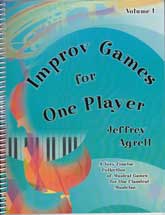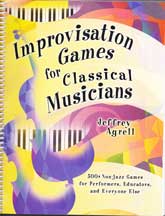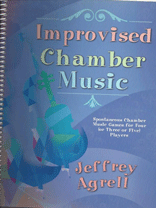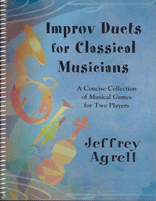
|
Four books by Jeffrey Agrell -Improvisation Games for Classical Musicans GIA Publications, 2008-2013
|
|
|
Ostensibly aimed at academically trained players, these three books address an issue long held as endemic to classical musicians: a self-imposed inability to improvise. Each volume comprises large variety of insight-provoking, direction-changing "games" and exercises which focus on types of proactive details (shifting interactions, player/orchestration awareness, situational set-ups, aural mechanisms, etc.), all specifically designed to unglue classically-trained music readers from the sheet music. These games generally resemble instances of the sorts of phenomena that we run across all the time perchance in free improvising sessions, which Agrell has isolated and categorized, and presented somewhat in the style of a field guide. These books are spiral bound and, like the ubiquitous jazz standards "fake books," they are obviously meant to be integral to the making of the music. As such they fall definitely in the "how-to" department of free improvising, which might seem a conundrum to someone who finds improvisation to be a self-evident and self-revealing process. However, there has long existed a need for this kind of instruction within the homogeneous, repertoire-driven milieu of the musical academia, which has traditionally insisted that improvisation is either an amusing aside or mindless noodling, sometimes "taken seriously" as an entirely illegitimate activity; at any rate unnerving to undertake for fear of sounding unprofessionally "wrong." While both of these concerns may seem laughable to committed improvisers, this can be a real issue for those who have always played music only according to how they were instructed and directed by their professors and conductors. That is, in terms of improvising, some of the very finest musicians are total novices, having never encountered working concepts of real-time music making via in-the-moment invention. These exercises and etudes seem intended as 'gateway' techniques, so to speak, although the upshot still seems oddly product-oriented. For example, consider this passage from the introduction to "Improvised Chamber Music:"
"Before you
know it, you will be able to perform a new piece along with your regular
chamber ensemble repertoire. Watch the delight and wonder on the
audience's faces as they hear you make up on the spot a very cool new
piece..." Well, of course he's right about that in many instances, although if these games are played out thoroughly, into the extreme realms of complete sonic inclusion, there can exist under certain performance circumstances an excellent chance that this 'very cool new piece' can find the musicians on the spot indeed, watching something very unlike delight and wonder on the audience's faces. Possibly irrelevant audience reactions aside, such extremes might not be crucial to the intentions set forth in these four (slightly overlapping) textbooks anyway, however. At any rate, by including 'an improvisation piece' as part of the "regular" repertoire, Mr. Agrell is not necessarily advocating free improvisation as a singular-focus endeavor, but he is quite significantly supplying its technique as an invaluable adjunct to conventional composer/performer methods of music making. Therefore, from the standpoint of free improvisation at large, these books constitute an important, even vital component of modern musical pedagogy. DJW
|



